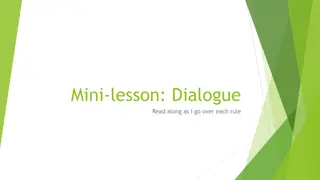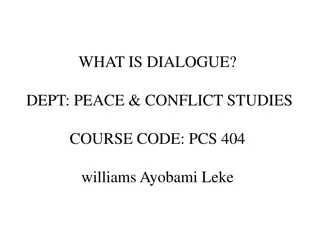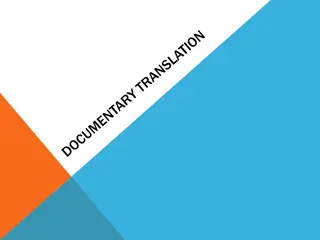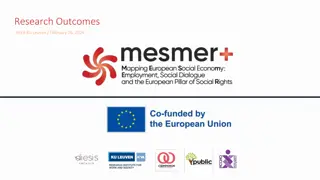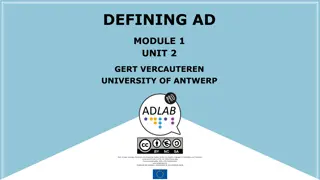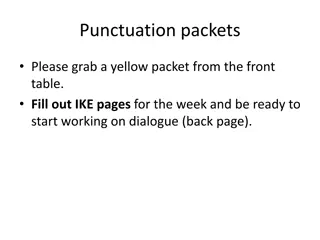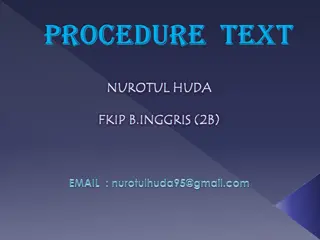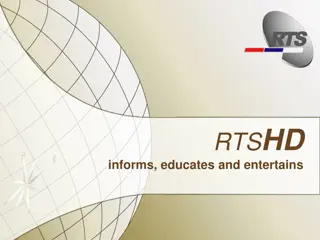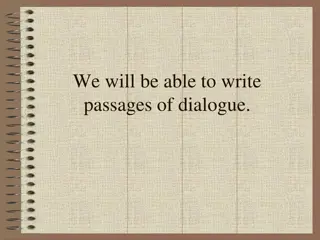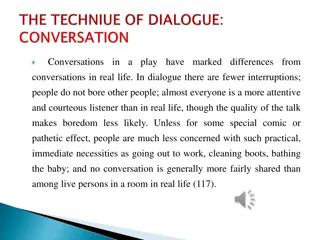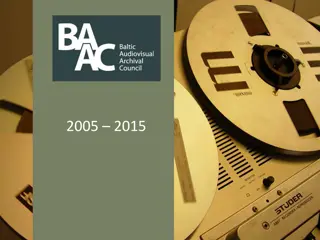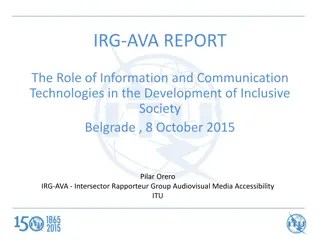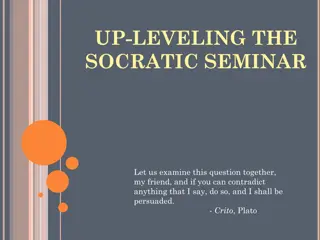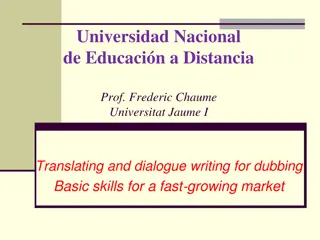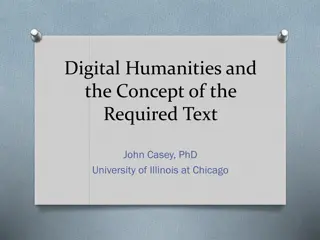Understanding Dubbed Dialogue in Audiovisual Texts
Film dialogue, dubbed for lip sync, differs from natural conversation due to prefabricated orality. Translations may lack naturalness, leading to dubbese with unidiomatic language use. While fidelity to the original is less crucial in dubbing, achieving naturalness and lip sync is paramount. Matching visemes for proper lip sync and changing word order are strategies employed in translating dialogue for audiovisual texts.
Download Presentation

Please find below an Image/Link to download the presentation.
The content on the website is provided AS IS for your information and personal use only. It may not be sold, licensed, or shared on other websites without obtaining consent from the author.If you encounter any issues during the download, it is possible that the publisher has removed the file from their server.
You are allowed to download the files provided on this website for personal or commercial use, subject to the condition that they are used lawfully. All files are the property of their respective owners.
The content on the website is provided AS IS for your information and personal use only. It may not be sold, licensed, or shared on other websites without obtaining consent from the author.
E N D
Presentation Transcript
Dialogue is written by scriptwriters and later delivered by actors in such a way as to maintain the illusion of spontaneity and naturalness, but film dialogue is often different from natural conversation as it does not contain so many false starts, repetitions, hesitations, etc. Audiovisual texts are thus characterised by discourse that is spoken and seemingly spontaneous, yet planned and elaborated This has been captured by the concept known as prefabricated orality prefabricated orality
In an attempt to comply with lip sync and other synchronisation requirements, dubbed dialogue sometimes resembles the original in following its syntactic structures or imitating its lexical choices. According to Banos (2014), the linguistic patterning of domestic and dubbed fictional dialogues differs significantly (p. 407).
In consequence, translated dialogue does not sound natural in the target language, and viewers can often recognise that what they are watching is a translated rather than an original version. This specific type of discourse has come to be known as dubbese by unidiomatic language use and calques. The artificial nature of dubbed dialogue has been demonstrated, for instance, in unidiomatic turns of phrase, Anglicisms, or interjections dubbese, alluding to translationese, characterised
Due to the stringent demands of synchronisation, maintaining strict faithfulness to the original is often not the primary focus in dubbing. As V ge (1977, p. 120) suggests, if synchrony is the overruling requirement, this automatically implies a translation which is less than faithful to the original . Instead of faithfulness, the emphasis lies on achieving naturalness and credibility in dialogue, as well as maintaining lip sync and isochrony (D ugosz, 2004). Consequently, certain translation strategies employed in dubbing diverge significantly from those used in other forms of AVT.
Matching To ensure proper lip sync, dialogue writers often prioritise solutions that align with the mouth movements on screen, rather than strict accuracy in translation. In essence, they select words or expressions that match the visemes displayed. For instance, when translating the English phrase I m sorry into Arabic, the typical translation would be Matching visemes visemes m .
Changing word order Chaume (2014, p. 74) also notes that lip sync strategies may require the translator or dialogue writer to change the order of the words. For example, the English utterance the p parson has a house which b belonged to could be rendered into Arabic as .... Changing word order
Repetition Because of synchrony requirements, a convenient translation technique employed by dialogue writers is to use a target language word that is identical or very similar to the source language word. For instance, English football will conveniently become futbol in Polish, Fu ball in German or f tbol in Spanish. This could also mean retaining a source language word, such as a cultural reference, in its original form if it can be assumed to be known in the target language, e.g. Halloween. Repetition
Literal translation Dubbing translators sometimes resort to direct or literal translation. This strategy can be used to translate established equivalents. For instance, Literal translation Charity begins at home. Diamonds Charity begins at home. Diamonds cut diamonds. cut diamonds.
Literal translation However, literal translation in dubbing often comes at a cost: as demonstrated by a number of descriptive studies which analysed translation strategies used in dubbing, translators often resort to literal translations instead of creating idiomatic expressions which would sound more natural in the target language (see Ranzato, 2016; or Romero- Fresco, 2009). The reason for this is that it may sometimes be easier to stick to the structure and phrasing of the original text to maintain isochrony and lip sync. By focusing too much on literal translations, the resulting dubbed product can often sound unnatural and fall into the category of dubbese. Literal translation
Amplification or reduction In order to maintain isochrony especially in lip- readable shots and adhere to the time constraints of the original dialogue, dialogue writers often face the need to expand or reduce their translations. Amplification or reduction
Reduction When the target text exceeds the length of the original dialogue, reduction becomes necessary. This reduction elements and non- essential linguistic components, such as interjections, modal verbs, vocatives, and any redundancies with the images (Chaume, 2014, p. 73). Additionally, deictic expressions like this or here can be used as substitutes for longer proper names or phrases as part of the reduction strategy. However, unlike in subtitling or VO, all sounds produced by actors, both verbal and non- verbal, must be included in the dubbed version. Reduction reduction strategy involves removing phatic
If the target text is shorter than the original dialogue, it may need to be expanded. Chaume (2014, p. 73) calls this strategy amplification explains that it may take the form of repetition, explanation, and paraphrase, as well as using longer synonyms. He also notes that these solutions confer a fresher and more oral touch to the translation, another of the agreed dubbing standards (Chaume, 2014, p. 73). amplification and
Substitution Chaume (2014) argues there is a conscious agenda to domesticate the translated text (p. 69) in order to create an illusion of reality. Domestication may involve replacing the original names of characters and places with others, typically from the target culture (Baker & Hochel, 1998). As the original language cannot be heard in dubbing, this type of AVT allows translators to replace foreign elements, for instance when they are assumed to be unknown to the target viewers, with more familiar items. This strategy is known as substitution or cultural adaptation. Chaume (2014) notes that this strategy Substitution
When a film or TV series is produced in a particular language variety, it is usually translated into the standard form of the target language. In terms of translating dialects, Chaume (2014) summarises the general approach by stating that most authors agree that dialects have no equivalents in other languages, and that equating the dialect of a source language in the source film to another dialect from the target language in the target version can be politically incorrect
Dialects can serve an important function in cinema, adding to authenticity and realism. Filmmakers use dialects to heritage, to locate each person in terms of his or her financial standing, education level, geographical background, or ethnic group However, using clich d dialects can lead to racial stereotyping, which Hollywood has historically been guilty of (Kozloff, 2000). A famous example is the Black Vernacular English used by Mammy in Gone with the Wind ( I think he gonna shoot hisself , You know what trouble I s talkin bout. I s talking bout Mr. Ashley Wilkes. Dialects can serve an important function in cinema, adding to authenticity and realism. Filmmakers use dialects to sketch in a character heritage, to locate each person in terms of his or her financial standing, education level, geographical background, or ethnic group (Kozloff, 2000, p. 82). sketch in a character s past and cultural s past and cultural
THANK YOU




